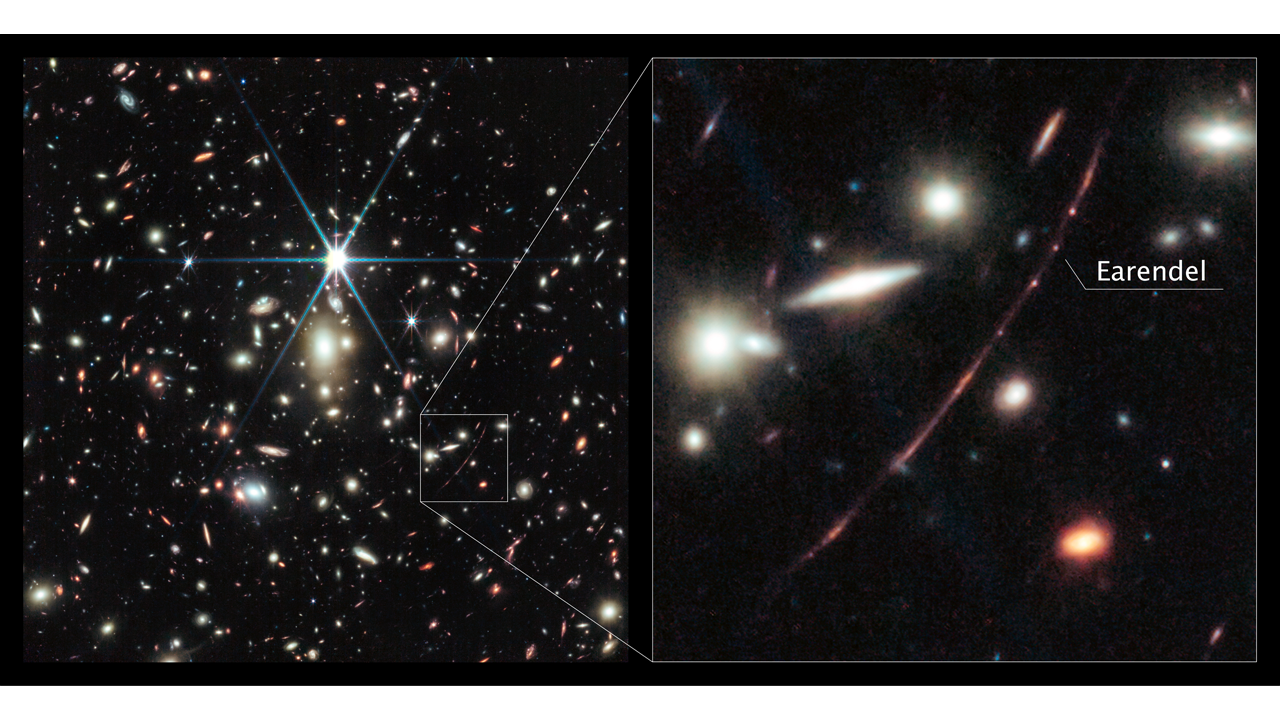🔭 Earendel: the most distant star ever observed might be a completely different object
Follow us on Google News (click on ☆)
Discovered in 2022 by the Hubble Space Telescope, Earendel was initially identified as an individual star dating back to the early ages of the Universe. A new study published in The Astrophysical Journal challenges this classification, suggesting that Earendel could be something entirely different: a globular cluster, a dense group of stars bound together by gravity.

A massive galactic cluster (left) magnifies the light of what was until now perceived as the most distant star detected in the Universe (right).
Image credit: NASA, ESA, CSA, D. Coe, B. Welch. Image processing: Z. Levay.
Researchers used the James Webb Space Telescope to analyze Earendel's light. Their findings indicate that the object's spectral characteristics match those of known globular clusters in our cosmic neighborhood. This discovery opens new perspectives on the formation of the earliest stellar structures.
Earendel's location in the gravitational arc of a distant galaxy allowed its observation despite its phenomenal distance. This phenomenon, predicted by Einstein's theory of general relativity, amplifies the light of objects located behind massive galaxy clusters, acting as a cosmic lens.
Scientists emphasize the need for further observations to confirm Earendel's true nature. Variations in brightness due to gravitational microlensing could provide crucial clues, helping to distinguish between a single star and a star cluster.
This study highlights the challenges of observing the oldest objects in the Universe. However, technological advancements, such as those enabled by the James Webb Telescope, continue to push the boundaries of our observations further.
What is a globular cluster?
Globular clusters are spherical collections of stars, bound by gravity, that orbit around galactic cores. They contain hundreds of thousands, or even millions, of stars.
These clusters are among the oldest structures in the Universe, with ages often comparable to that of the Universe itself. Studying them provides valuable insights into the conditions during the earliest phases of galaxy formation.
Stars in a globular cluster were born roughly at the same time, from the same cloud of gas and dust. This makes them natural laboratories for studying stellar evolution and the chemical composition of ancient stars.
Unlike open clusters, which are younger and less dense, globular clusters are highly compact. Their high density can lead to frequent stellar interactions, such as collisions or mergers between stars.
How does gravitational lensing work?
Gravitational lensing is an astrophysical phenomenon where the light from a distant object is bent and amplified by the gravity of a massive object located between the observer and the light source.
This phenomenon, predicted by Einstein's theory of general relativity, allows astronomers to observe objects that would otherwise be too faint or too distant to detect. It acts like a cosmic magnifying glass, distorting and sometimes multiplying the image of the background object.
There are several types of gravitational lenses: strong lenses, which produce multiple images or Einstein rings, and weak lenses, which subtly distort the images of distant galaxies. Microlensing, on the other hand, is caused by smaller objects like stars or planets.
Gravitational lensing is a powerful tool for studying the distribution of dark matter in the Universe, as this invisible matter influences how light is bent. It also helps measure cosmic distances and explore the properties of the most distant objects in the Universe.